英文标点符号用法
英文标点符号的用法重要提示:句号和冒号应该在引号内
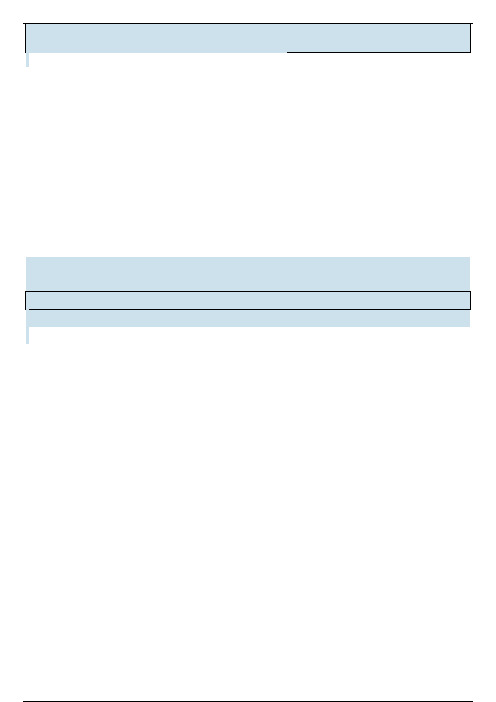
号之内;冒号和分号必须置于引号之外;如果所引内容本身是疑问句或感叹句,问号和感叹号一般放在引号之内,否则,问号和感叹号则放在引号之外。
(2) 日-月-年次序的日期中的逗号错误。
英语日期的表达可以用月-日-年的次序和日-月-年的次序,日和年之间加逗号而月和年之间习惯上不加逗号。
例如: 误把"13 August 2002"写成"13 August , 2002"。
(3) 在部分副词如perhaps , so 后加逗号。
(4) 连接号(hyphen)错误。
许多英语习作者往往随意用连接号派生单词,如把"boyfriend"写成"boy-friend";"middle school"写成"middle -school"。
在行末单词分行时,连接号使用错误更多。
与之相反,若把本应有的连接号粗心删去,其单词含义可能会大相径庭。
She slowly, carefully, deliberately moved the box.注意:类似的情况下,最后一个逗号后可加and,这个逗号也可省略--She slowly, carefully(,) and deliberately moved the box.⑵ 书名号(《》):英文没有书名号,书名、报刊名用斜体或者下划线表示。
如:Hamlet / Hamlet 《哈姆雷特》 Winter's Tale / Winter's Tale 《冬天的童话》The New York Times / The New York Times 《纽约时报》另外,英语中文章、诗歌、乐曲、电影、绘画等的名称和交通工具、航天器等的专有名词也常用斜体来表示。
⑶ 间隔号(·):汉语有间隔号,用在月份和日期、音译的名和姓等需要隔开的词语的正中间,如"一二·九"、"奥黛丽·赫本(人名)"等。
英文标点符号的基本用法

英文标点符号的基本用法句点(Full Stop / Period , “ . ”问号(Question Mark , “ ? ”感叹号(Exclamation Mark , “ ! ”分号(Semicolon , “ ; ”冒号(Colon , “ :”逗点(Comma , “ , ”连字符(Hyphen , “ -”连接号(En Dash , “ –”破折号(Em Dash , “ —”括号 (Parentheses , 小括号“ ( ” ; 中括号“ []” ; 大括号“ {}”引号 (Quotation Marks , 双引号“ “” ” ; 单引号“ …‟ ”省略号(Ellipsis Mark , “ … ”缩写及所有格符号(Apostrophe , “ ’ ”下划线 Underline(Underline 和斜体 Italics(Italics一、 . 句点1. 句点用于一句话完全结束时。
2. 句点也可以用于英文单词的缩写 ,如 Mrs., Dr., P.S., etc. 等。
注意 :(1 但当缩写词已广为人知时一般不需使用句点。
如 IBM, DNA 等。
(2 当缩写词带有句点 , 且位于句末时 , 无需使用双重句点。
如 Mr. Smith grew up in Washington D.C. 句末无须再加句点。
二、 ? 问号问号用在一个直接的 (而不是间接的问句句末。
如 How will you solve the problem? 是正确的用法 , 但用在 I wonder how you will solve the problem? 就不对了 , 应该使用句点而不是问号。
注意 :(1 在客气的用语中 , 也是用句点而不是问号。
如 Will you ple ase give me a call t omorrow.(2 如果有一连串的问题 , 且含追问语气时 , 每句都需使用问号。
英语中标点符号的用法大全
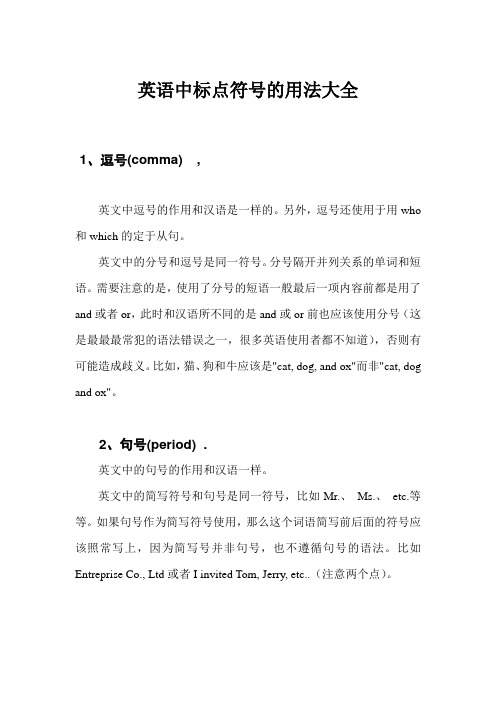
英语中标点符号的用法大全1、逗号(comma) ,英文中逗号的作用和汉语是一样的。
另外,逗号还使用于用who 和which的定于从句。
英文中的分号和逗号是同一符号。
分号隔开并列关系的单词和短语。
需要注意的是,使用了分号的短语一般最后一项内容前都是用了and或者or,此时和汉语所不同的是and或or前也应该使用分号(这是最最最常犯的语法错误之一,很多英语使用者都不知道),否则有可能造成歧义。
比如,猫、狗和牛应该是"cat, dog, and ox"而非"cat, dog and ox"。
2、句号(period) .英文中的句号的作用和汉语一样。
英文中的简写符号和句号是同一符号,比如Mr.、Ms.、etc.等等。
如果句号作为简写符号使用,那么这个词语简写前后面的符号应该照常写上,因为简写号并非句号,也不遵循句号的语法。
比如Entreprise Co., Ltd或者I invited Tom, Jerry, etc..(注意两个点)。
3、冒号(colon) :英文中的冒号的作用和汉语一样。
当冒号后是引用一个人说的话,也可以使用逗号。
4、分号(semi-colon) ;英文中的分号的作用和汉语一样。
需要注意的是,分号和逗号有时是可以互相交替的,比如如下的情况。
Tom met me, and later he met Joan.Tom met me; later he met Joan.或Tom hates cheese, but he likes butter.Tom hates cheese; he like butter, though.当只有两个句子相并列时,分号可以和被逗号+连结词互替。
但注意第二个例子里,but的转接意是需要用其他成份补充的。
5、引号(quotation mark)英文中的引号的作用和汉语一样,可用于引用和戏虐。
引号同时可以作为书名号,但只能使用于短诗歌,短故事,短电影和歌曲上。
英语中标点符号的用法大全英文中符号
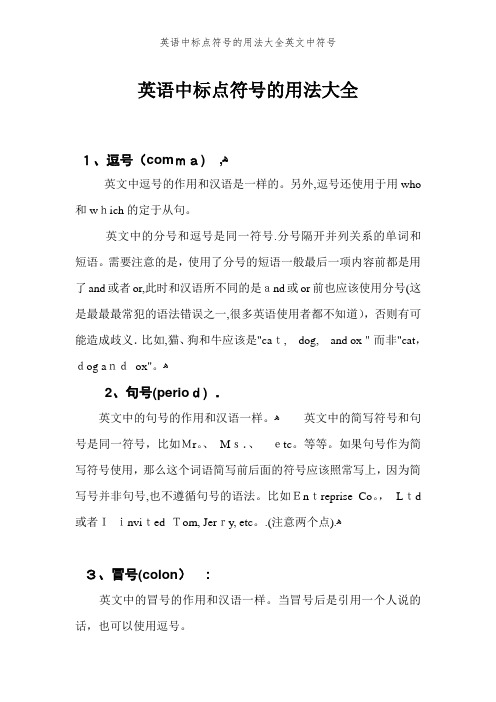
英语中标点符号的用法大全1、逗号(comma) ,ﻫ英文中逗号的作用和汉语是一样的。
另外,逗号还使用于用who 和which的定于从句。
英文中的分号和逗号是同一符号.分号隔开并列关系的单词和短语。
需要注意的是,使用了分号的短语一般最后一项内容前都是用了and或者or,此时和汉语所不同的是and或or前也应该使用分号(这是最最最常犯的语法错误之一,很多英语使用者都不知道),否则有可能造成歧义.比如,猫、狗和牛应该是"cat,dog,and ox"而非"cat,dog andox"。
ﻫ2、句号(period) .英文中的句号的作用和汉语一样。
ﻫ英文中的简写符号和句号是同一符号,比如Mr。
、Ms.、etc。
等等。
如果句号作为简写符号使用,那么这个词语简写前后面的符号应该照常写上,因为简写号并非句号,也不遵循句号的语法。
比如Entreprise Co。
,Ltd 或者Iinvited Tom, Jerry, etc。
.(注意两个点).ﻫ3、冒号(colon) :英文中的冒号的作用和汉语一样。
当冒号后是引用一个人说的话,也可以使用逗号。
ﻫ4、分号(semi—colon) ;ﻫ英文中的分号的作用和汉语一样。
需要注意的是,分号和逗号有时是可以互相交替的,比如如下的情况.ﻫ Tom met me, and later he met Joan。
Tom metme; laterhe met Joan。
ﻫ或ﻫTomhates cheese,but he likes butter.ﻫTom hatescheese; he like butter,though。
当只有两个句子相并列时,分号可以和被逗号+连结词互替。
但注意第二个例子里,but的转接意是需要用其他成份补充的。
ﻫ5、引号(quotationmark)英文中的引号的作用和汉语一样,可用于引用和戏虐。
ﻫ引号同时可以作为书名号,但只能使用于短诗歌,短故事,短电影和歌曲上.参见下文中“斜体字".在英国,引用原话应该使用单引号,而话中话应该使用双引号。
(英文)标点符号用法总结.doc
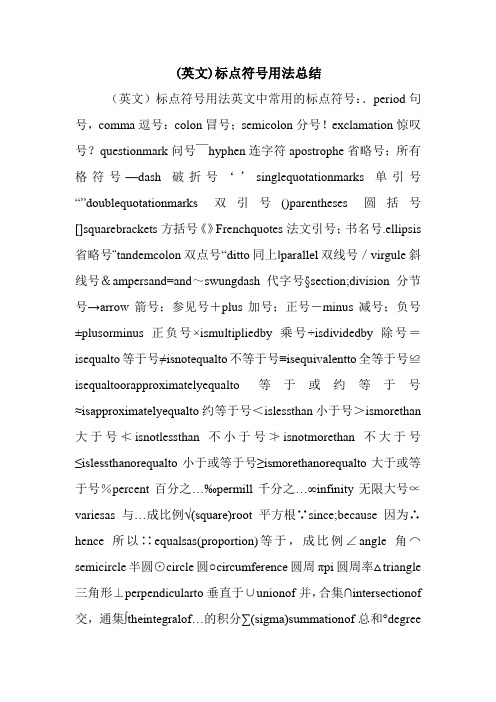
(英文)标点符号用法总结(英文)标点符号用法英文中常用的标点符号:.period句号,comma逗号:colon冒号;semicolon分号!exclamation惊叹号?questionmark问号 ̄hyphen连字符apostrophe省略号;所有格符号—dash破折号‘’singlequotationmarks单引号“”doublequotationmarks双引号()parentheses圆括号[]squarebrackets方括号《》Frenchquotes法文引号;书名号.ellipsis 省略号¨tandemcolon双点号“ditto同上‖parallel双线号/virgule斜线号&ampersand=and~swungdash代字号§section;division分节号→arrow箭号;参见号+plus加号;正号-minus减号;负号±plusorminus正负号×ismultipliedby乘号÷isdividedby除号=isequalto等于号≠isnotequalto不等于号≡isequivalentto全等于号≌isequaltoorapproximatelyequalto等于或约等于号≈isapproximatelyequalto约等于号<islessthan小于号>ismorethan 大于号≮isnotlessthan不小于号≯isnotmorethan不大于号≤islessthanorequalto小于或等于号≥ismorethanorequalto大于或等于号%percent百分之…‰permill千分之…∞infinity无限大号∝variesas与…成比例√(square)root平方根∵since;because因为∴hence所以∷equalsas(proportion)等于,成比例∠angle角⌒semicircle半圆⊙circle圆○circumference圆周πpi圆周率△triangle 三角形⊥perpendicularto垂直于∪unionof并,合集∩intersectionof 交,通集∫theintegralof…的积分∑(sigma)summationof总和°degree度′minute分″second秒#number…号℃Celsiussystem摄氏度@at 单价以下是具体使用方法(一)逗号的用法 1.在并列连词(and,but,for,nor,or,yet)前使用,用来连接句中的各分句。
英语中的标点符号
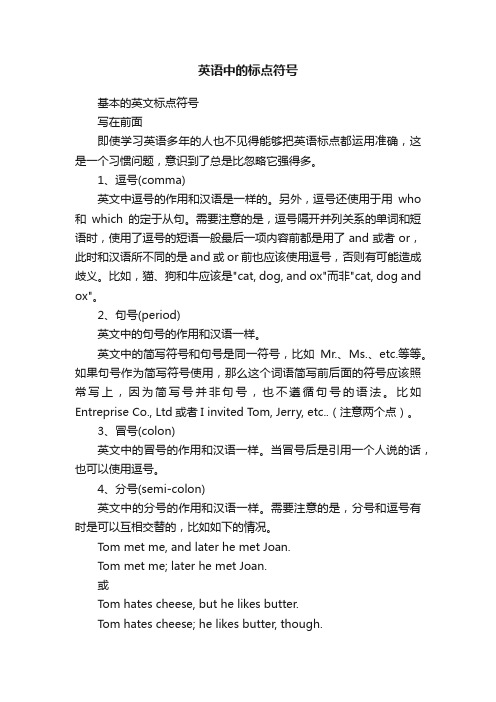
英语中的标点符号基本的英文标点符号写在前面即使学习英语多年的人也不见得能够把英语标点都运用准确,这是一个习惯问题,意识到了总是比忽略它强得多。
1、逗号(comma)英文中逗号的作用和汉语是一样的。
另外,逗号还使用于用who 和which的定于从句。
需要注意的是,逗号隔开并列关系的单词和短语时,使用了逗号的短语一般最后一项内容前都是用了and或者or,此时和汉语所不同的是and或or前也应该使用逗号,否则有可能造成歧义。
比如,猫、狗和牛应该是"cat, dog, and ox"而非"cat, dog and ox"。
2、句号(period)英文中的句号的作用和汉语一样。
英文中的简写符号和句号是同一符号,比如Mr.、Ms.、etc.等等。
如果句号作为简写符号使用,那么这个词语简写前后面的符号应该照常写上,因为简写号并非句号,也不遵循句号的语法。
比如Entreprise Co., Ltd或者I invited T om, Jerry, etc..(注意两个点)。
3、冒号(colon)英文中的冒号的作用和汉语一样。
当冒号后是引用一个人说的话,也可以使用逗号。
4、分号(semi-colon)英文中的分号的作用和汉语一样。
需要注意的是,分号和逗号有时是可以互相交替的,比如如下的情况。
Tom met me, and later he met Joan.Tom met me; later he met Joan.或Tom hates cheese, but he likes butter.Tom hates cheese; he likes butter, though.当只有两个句子相并列时,分号可以和被逗号+连结词互替。
但注意第二个例子里,but的转接意是需要用其他成份补充的。
5、引号(quotation mark)英文中的引号的作用和汉语一样,可用于引用和戏谑。
引号同时可以作为书名号,但只能使用于短诗歌,短故事,短电影和歌曲上。
英文标点符号的用法
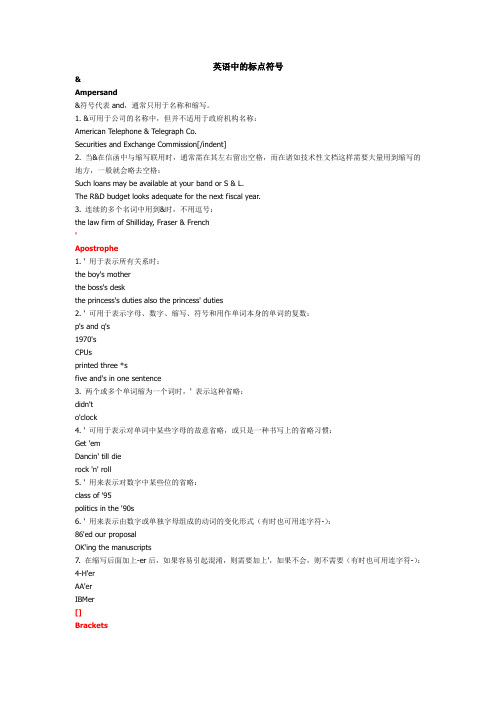
英语中的标点符号&Ampersand&符号代表and,通常只用于名称和缩写。
1. &可用于公司的名称中,但并不适用于政府机构名称:American Telephone & Telegraph Co.Securities and Exchange Commission[/indent]2. 当&在信函中与缩写联用时,通常需在其左右留出空格,而在诸如技术性文档这样需要大量用到缩写的地方,一般就会略去空格:Such loans may be available at your band or S & L.The R&D budget looks adequate for the next fiscal year.3. 连续的多个名词中用到&时,不用逗号:the law firm of Shilliday, Fraser & French'Apostrophe1. ' 用于表示所有关系时:the boy's motherthe boss's deskthe princess's duties also the princess' duties2. ' 可用于表示字母、数字、缩写、符号和用作单词本身的单词的复数:p's and q's1970'sCPUsprinted three *sfive and's in one sentence3. 两个或多个单词缩为一个词时,' 表示这种省略:didn'to'clock4. ' 可用于表示对单词中某些字母的故意省略,或只是一种书写上的省略习惯:Get 'emDancin' till dierock 'n' roll5. ' 用来表示对数字中某些位的省略:class of '95politics in the '90s6. ' 用来表示由数字或单独字母组成的动词的变化形式(有时也可用连字符-):86'ed our proposalOK'ing the manuscripts7. 在缩写后面加上-er后,如果容易引起混淆,则需要加上',如果不会,则不需要(有时也可用连字符-):4-H'erAA'erIBMer[]Brackets1. [] 用于编者插入的注释、修改、说明,或其他东西,尤其是在引语中:This was the first time since it became law that Twenty-first Amendment [outlining procedures for the replacement of a dead of incapacitated President or vice President] had been invoked.He wrote, "I am just as cheerful as when you was [sic] here."2. [] 用于插入被略去的字母:"If you can't persuade the P[resident], I'm sure no one can."3. [] 用于替换原文的插入文字:The report, entitled "A Decade of Progress," begins with a short message from President Stevens in which she notes that "the loving portraits and revealing accounts of [this report] are not intended to constitute a complete history of the decade....Rather [they] impact the flavor of the events, developments, and achievements of this vibrant period."4. [] 用于插入文字对原文的单词有轻微改动时:The magazine reported that thousands of the country's children were "go[ing] to bed hungry every night."5. [] 用于表示对原文的大小写或字样的某种改变:As we point out later, "...[L]ength can be assessed in terms of number of words,..."They agreed with and were encouraged by her next point: "They have been placed in positions of responsibility without being delegated enough authority to carry out the responsibility." [Italics added.] 对原文作出大小写的改变时,[]是可用可不用的,只有在对文字材料要求非常严格时(特别是法律文本)才是必需的。
英语中标点符号的使用(详解版)
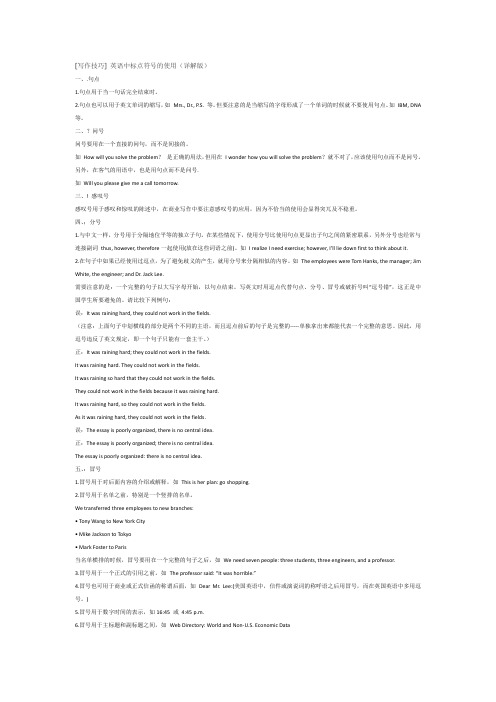
[写作技巧]英语中标点符号的使用(详解版)一、.句点1.句点用于当一句话完全结束时。
2.句点也可以用于英文单词的缩写,如Mrs., Dr., P.S. 等。
但要注意的是当缩写的字母形成了一个单词的时候就不要使用句点。
如IBM, DNA 等。
二、?问号问号要用在一个直接的问句,而不是间接的。
如How will you solve the problem?是正确的用法,但用在I wonder how you will solve the problem?就不对了,应该使用句点而不是问号。
另外,在客气的用语中,也是用句点而不是问号.如Will you please give me a call tomorrow.三、! 感叹号感叹号用于感叹和惊叹的陈述中,在商业写作中要注意感叹号的应用,因为不恰当的使用会显得突兀及不稳重。
四、;分号1.与中文一样,分号用于分隔地位平等的独立子句。
在某些情况下,使用分号比使用句点更显出子句之间的紧密联系,另外分号也经常与连接副词thus, however, therefore一起使用(放在这些词语之前)。
如I realize I need exerci se; however, I’ll lie down first to think about it.2.在句子中如果已经使用过逗点,为了避免歧义的产生,就用分号来分隔相似的内容。
如The employees were Tom Hanks, the manager; Jim White, the engineer; and Dr. Jack Lee.需要注意的是:一个完整的句子以大写字母开始,以句点结束。
写英文时用逗点代替句点、分号、冒号或破折号叫“逗号错”,这正是中国学生所要避免的。
请比较下列例句:误:It was raining hard, they could not work in the fields.(注意:上面句子中划横线的部分是两个不同的主语,而且逗点前后的句子是完整的-----单独拿出来都能代表一个完整的意思。
英文标点符号的正确用法
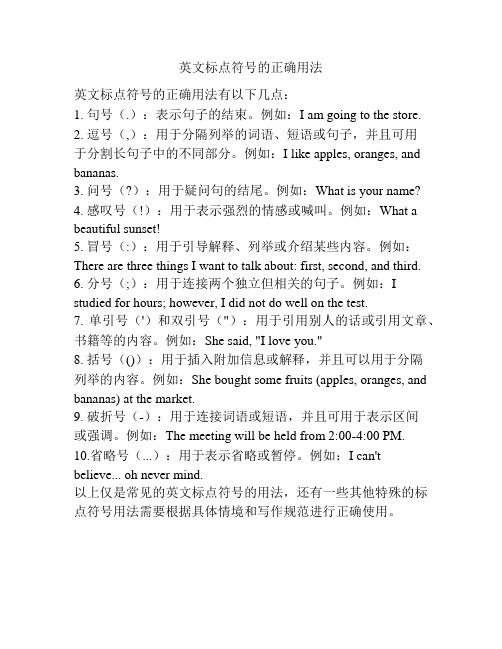
英文标点符号的正确用法英文标点符号的正确用法有以下几点:1. 句号(.):表示句子的结束。
例如:I am going to the store.2. 逗号(,):用于分隔列举的词语、短语或句子,并且可用于分割长句子中的不同部分。
例如:I like apples, oranges, and bananas.3. 问号(?):用于疑问句的结尾。
例如:What is your name?4. 感叹号(!):用于表示强烈的情感或喊叫。
例如:What a beautiful sunset!5. 冒号(:):用于引导解释、列举或介绍某些内容。
例如:There are three things I want to talk about: first, second, and third.6. 分号(;):用于连接两个独立但相关的句子。
例如:I studied for hours; however, I did not do well on the test.7. 单引号(')和双引号("):用于引用别人的话或引用文章、书籍等的内容。
例如:She said, "I love you."8. 括号(()):用于插入附加信息或解释,并且可以用于分隔列举的内容。
例如:She bought some fruits (apples, oranges, and bananas) at the market.9. 破折号(-):用于连接词语或短语,并且可用于表示区间或强调。
例如:The meeting will be held from 2:00-4:00 PM. 10.省略号(...):用于表示省略或暂停。
例如:I can't believe... oh never mind.以上仅是常见的英文标点符号的用法,还有一些其他特殊的标点符号用法需要根据具体情境和写作规范进行正确使用。
英文标点符号的用法
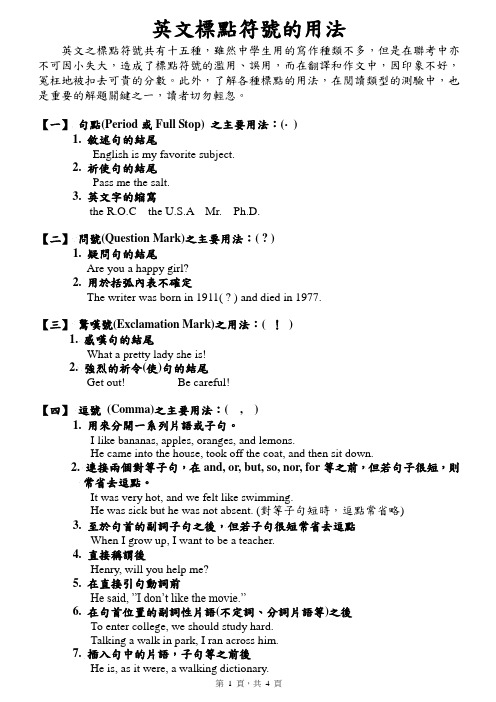
英文標點符號的用法英文之標點符號共有十五種,雖然中學生用的寫作種類不多,但是在聯考中亦不可因小失大,造成了標點符號的濫用、誤用,而在翻譯和作文中,因印象不好,冤枉地被扣去可貴的分數。
此外,了解各種標點的用法,在閱讀類型的測驗中,也是重要的解題關鍵之一,讀者切勿輕忽。
【一】句點(Period或Full Stop) 之主要用法:(‧)1. 敘述句的結尾English is my favorite subject.2. 祈使句的結尾Pass me the salt.3. 英文字的縮寫the R.O.C the U.S.A Mr. Ph.D.【二】問號(Question Mark)之主要用法:( ? )1. 疑問句的結尾Are you a happy girl?2. 用於括弧內表不確定The writer was born in 1911( ? ) and died in 1977.【三】驚嘆號(Exclamation Mark)之用法:( !)1. 感嘆句的結尾What a pretty lady she is!2. 強烈的祈令(使)句的結尾Get out! Be careful!【四】逗號(Comma)之主要用法:( , )1. 用來分開一系列片語或子句。
I like bananas, apples, oranges, and lemons.He came into the house, took off the coat, and then sit down.2. 連接兩個對等子句,在and, or, but, so, nor, for等之前,但若句子很短,則常省去逗點。
It was very hot, and we felt like swimming.He was sick but he was not absent. (對等子句短時,逗點常省略)3. 至於句首的副詞子句之後,但若子句很短常省去逗點When I grow up, I want to be a teacher.4. 直接稱謂後Henry, will you help me?5. 在直接引句動詞前He said, ”I don‟t like the movie.”6. 在句首位置的副詞性片語(不定詞、分詞片語等)之後To enter college, we should study hard.Talking a walk in park, I ran across him.7. 插入句中的片語,子句等之前後He is, as it were, a walking dictionary.8. 同位語之字、片語,或非限定子句之前後----若同位語在句尾,則只在同位語前用逗號.Mr. Young, a doctor, lives in Taipei.I like her eldest brother, who is an athlete.9. 附加問句前He is a student, isn‟t he?10. 時間、地點之分隔I was born in Tainan, Taiwan, in 1968.He lives at 123 Park Street, Taipei, Taiwan.11. 感嘆詞在句首與其他部分之分隔Oh, I wish I were young!12. Yes, No等回應用語後Yes, I will do it.Of course, it is difficult.13. 書信中,稱呼及結尾語之後Dear Mr. Lin,Sincerely,Dear Mother,Your son,14. 句子太長時,可供斷句休息用。
英文标点符号的使用方法

英文标点符号的使用方法一、.句点1.句点用于当一句话完全结束时。
2.句点也可以用于英文单词的缩写,如Mrs., Dr., P.S. 等。
但要注意的是当缩写的字母形成了一个单词的时候就不要使用句点。
如IBM, DNA 等。
二、问号问号要用在一个直接的问句,而不是间接的。
如How will you solve the problem? 是正确的用法,但用在I wonder how you will solve the problem?就不对了,应该使用句点而不是问号。
另外,在客气的用语中,也是用句点而不是问号.如Will you please give me a call tomorrow.三、! 感叹号感叹号用于感叹和惊叹的陈述中,在商业写作中要注意感叹号的应用,因为不恰当的使用会显得突兀及不稳重。
四、;分号1.与中文一样,分号用于分隔地位平等的独立子句。
在某些情况下,使用分号比使用句点更显出子句之间的紧密联系,另外分号也经常与连接副词thus, however, therefore一起使用(放在这些词语之前)。
如I realize I need exercise; however, I’ll lie down first to think about it.2.在句子中如果已经使用过逗点,为了避免歧义的产生,就用分号来分隔相似的内容。
如The employees were Tom Hanks, the manager; Jim White, the engineer; and Dr. Jack Lee.需要注意的是:一个完整的句子以大写字母开始,以句点结束。
写英文时用逗点代替句点、分号、冒号或破折号叫“逗号错”,这正是中国学生所要避免的。
请比较下列例句:误:It was raining hard, they could not work in the fields.(注意:上面句子中划横线的部分是两个不同的主语,而且逗点前后的句子是完整的-----单独拿出来都能代表一个完整的意思。
英文标点符号的使用
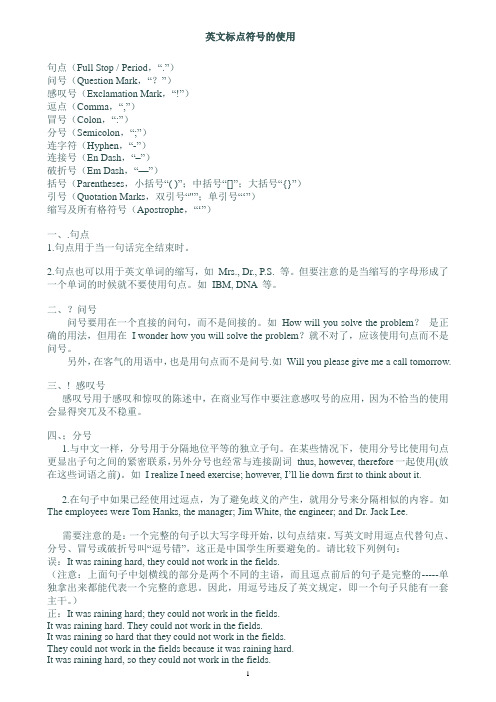
英文标点符号的使用句点(Full Stop / Period,―.‖)问号(Question Mark,―?‖)感叹号(Exclamation Mark,―!‖)逗点(Comma,―,‖)冒号(Colon,―:‖)分号(Semicolon,―;‖)连字符(Hyphen,―-‖)连接号(En Dash,―–‖)破折号(Em Dash,―—‖)括号(Parentheses,小括号―( )‖;中括号―[]‖;大括号―{}‖)引号(Quotation Marks,双引号―"‖;单引号―‗‖)缩写及所有格符号(Apostrophe,―‗‖)一、.句点1.句点用于当一句话完全结束时。
2.句点也可以用于英文单词的缩写,如Mrs., Dr., P.S. 等。
但要注意的是当缩写的字母形成了一个单词的时候就不要使用句点。
如IBM, DNA 等。
二、?问号问号要用在一个直接的问句,而不是间接的。
如How will you solve the problem?是正确的用法,但用在I wonder how you will solve the problem?就不对了,应该使用句点而不是问号。
另外,在客气的用语中,也是用句点而不是问号.如Will you please give me a call tomorrow.三、! 感叹号感叹号用于感叹和惊叹的陈述中,在商业写作中要注意感叹号的应用,因为不恰当的使用会显得突兀及不稳重。
四、;分号1.与中文一样,分号用于分隔地位平等的独立子句。
在某些情况下,使用分号比使用句点更显出子句之间的紧密联系,另外分号也经常与连接副词thus, however, therefore一起使用(放在这些词语之前)。
如I realize I need exercise; however, I‘ll lie down first to think about it.2.在句子中如果已经使用过逗点,为了避免歧义的产生,就用分号来分隔相似的内容。
英语标点符号的用法
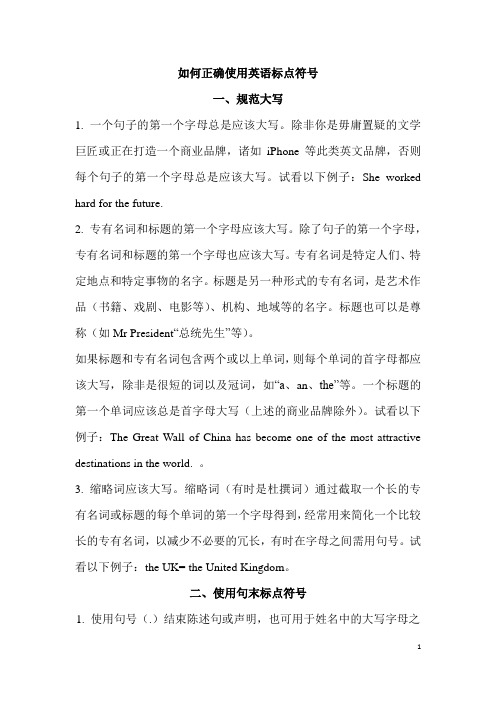
如何正确使用英语标点符号一、规范大写1. 一个句子的第一个字母总是应该大写。
除非你是毋庸置疑的文学巨匠或正在打造一个商业品牌,诸如iPhone等此类英文品牌,否则每个句子的第一个字母总是应该大写。
试看以下例子:She worked hard for the future.2. 专有名词和标题的第一个字母应该大写。
除了句子的第一个字母,专有名词和标题的第一个字母也应该大写。
专有名词是特定人们、特定地点和特定事物的名字。
标题是另一种形式的专有名词,是艺术作品(书籍、戏剧、电影等)、机构、地域等的名字。
标题也可以是尊称(如Mr President“总统先生”等)。
如果标题和专有名词包含两个或以上单词,则每个单词的首字母都应该大写,除非是很短的词以及冠词,如“a、an、the”等。
一个标题的第一个单词应该总是首字母大写(上述的商业品牌除外)。
试看以下例子:The Great Wall of China has become one of the most attractive destinations in the world. 。
3. 缩略词应该大写。
缩略词(有时是杜撰词)通过截取一个长的专有名词或标题的每个单词的第一个字母得到,经常用来简化一个比较长的专有名词,以减少不必要的冗长,有时在字母之间需用句号。
试看以下例子:the UK= the United Kingdom。
二、使用句末标点符号1. 使用句号(.)结束陈述句或声明,也可用于姓名中的大写字母之后,如:Agnes D. Smith。
每个句子都有至少一个标点符合,即句末符号,句号就是其中最常见的一种符号(称为period或full stop)。
英语中的句号为一个小圆点,标志着一个陈述句的结束。
大部分句子都是陈述性的。
陈述句即陈述一个事实、解释一个想法的句子,如:Monkeys like eating bananas.2. 使用问号(?)结束问题。
英文标点符号用法

英文标点符号使用详解A. 英语标点符号的种类1. 句点(Full Stop / Period,“.”)2. 问号(Question Mark,“?”)3. 感叹号(Exclamation Mark,“!”)4. 逗点(Comma,“,”)4. 冒号(Colon,“:”)6. 分号(Semicolon,“;”)7. 连字符(Hyphen,“-”)8. 连接号(En Dash,“–”)9. 破折号(Em Dash,“—”)10. 括号(Parentheses,小括号“( )”;中括号“[]”;大括号“{}”)11. 引号(Quotation Marks,双引号“"”;单引号“‘”)12. 缩写及所有格符号(Apostrophe,“‘”)B. 英文标点符号使用详解一、逗号英语中,逗号是最常用的标点符号,表示最短的停顿。
主要作用是:1. 用于表示并列的词语、结构或句子之间,如:He came in, took his bag, and then hurried away. 他进来,拿起他的包,然后匆匆离去了。
You, he and I should help one another. 我、你、他应该互相帮助。
2. 不属于句子组成成分的词或词组,如称呼语,插入语,well、yes、no 等,须用逗号与句子的其他成分隔开。
如:Tom, take care! 汤姆,当心!No, I don’t think so. 不,我认为不是这样。
3. 状语或状语从句置于句首时,须用逗号把它和其他成分或主句隔开。
如:On July 2, 1995, I graduated and found a teaching job in a college. 1995年7月2日,我毕业了,在一家大学找到了一份教书的工作。
If it rains tomorrow, our party will have to be put off. 如果明天下雨,我们的晚会就得推迟。
英文标点符号的使用

2.在句子中如果已经使用过逗点,为了避免歧义的产生,就用分号来分隔相似的内容。如 The employees were Tom Hanks, the
manager; Jim White, the engineer; and Dr. Jack Lee.
lease.
2.用于区分同一词源
3. 当某复合词中出现重复的字母或过多的元音, 使阅读困难时, 可用连字号把前缀和词根分开。
non-nuclear, re-use, semi-independent
4. 构成某些复合数字(在英文写作中,100以下的数字应该用英文单词写出来,不可用阿拉伯数字代替)
pipes froze.
6.逗点用于直接引用的句子之前,如 Mary said, “Let’s go
fishing.”(注意:这里说的和上面提及的冒号在直接引语中的使用不一样。如果是引用比较正式的发言讲话就要用冒号,一般情况下就用逗点。)
2.用来表示其中插入的或附加的解释成分。这个插入成分可以是单词、词组或句子.但要注意,括号会削弱强调作用,因此,如果要强调插入的句子成份,则要用破折号。
They might take a walk together(remember feet) and see the neighborhood
4.逗点用于关联的子句之间,如 Since he’s your younger brother, please take care of him.
5.逗点用于一个较长的修饰短语之后,如 In the middle of the coldest winter on record, the
英语中标点符号的使用(详解版)

[写作技巧]英语中标点符号的使用(详解版)一、.句点1.句点用于当一句话完全结束时。
2.句点也可以用于英文单词的缩写,如Mrs., Dr., P.S. 等。
但要注意的是当缩写的字母形成了一个单词的时候就不要使用句点。
如IBM, DNA 等。
二、?问号问号要用在一个直接的问句,而不是间接的。
如How will you solve the problem?是正确的用法,但用在I wonder how you will solve the problem?就不对了,应该使用句点而不是问号。
另外,在客气的用语中,也是用句点而不是问号.如Will you please give me a call tomorrow.三、! 感叹号感叹号用于感叹和惊叹的陈述中,在商业写作中要注意感叹号的应用,因为不恰当的使用会显得突兀及不稳重。
四、;分号1.与中文一样,分号用于分隔地位平等的独立子句。
在某些情况下,使用分号比使用句点更显出子句之间的紧密联系,另外分号也经常与连接副词thus, however, therefore一起使用(放在这些词语之前)。
如I realize I need exerci se; however, I’ll lie down first to think about it.2.在句子中如果已经使用过逗点,为了避免歧义的产生,就用分号来分隔相似的内容。
如The employees were Tom Hanks, the manager; Jim White, the engineer; and Dr. Jack Lee.需要注意的是:一个完整的句子以大写字母开始,以句点结束。
写英文时用逗点代替句点、分号、冒号或破折号叫“逗号错”,这正是中国学生所要避免的。
请比较下列例句:误:It was raining hard, they could not work in the fields.(注意:上面句子中划横线的部分是两个不同的主语,而且逗点前后的句子是完整的-----单独拿出来都能代表一个完整的意思。
标点符号用法

英文标点符号的用法一、“:”冒号1、冒号用于对后面内容的介绍或解释,如This is her plan:go shopping.2、冒号用于名单之前,特别是一个竖排的名单。
We transferred three employees to new branches:Tony Wang to New York CityMike Jackson to TokyoMark Foster to Paris当名单横排的时候,冒号要用在一个完整的句子之后,如We need seven people:three students,three engineers,and a professor.3、冒号用于一个正式的引用之前。
如The professor said:“It was horrible.”4、冒号也可用于商业或正式信函的称谓后面,如Dear Mr. Lee:(美国英语中,信件或演说词的称呼语之后用冒号,而在英国英语中多用逗号。
)5、冒号用于数字时间的表示,如16:45 或4:45 p.m.6、冒号用于主标题和副标题之间,如Web Directory:World and Non-U.S. Economic Data二、“,”逗点1、逗点用于分隔一系列的简单内容,如I will go to Shanghai,Beijing,and Shenzhen.2、逗点用于修饰名词的多个形容词之间,如a small,fancy bike(注意:1-2点的逗号在汉语里是顿号“、”,即汉语中并列成分使用顿号。
)3、逗点用于连接两个较长的独立子句,而且每个句子的主语不同,如The Grizzlies were outof timeouts,and Miller missed a desperation 3-pointer as time expired.4、逗点用于关联的子句之间,如Since he…s your younger brother,please take care of him.5、逗点用于一个较长的修饰短语之后,如In the middle of the coldest winter on record,thepipes froze.6、逗点用于直接引用的句子之前,如Mary said,“Let…s go fishing.”(注意:这里说的和上面提及的冒号在直接引语中的使用不一样。
英文标点符号的使用
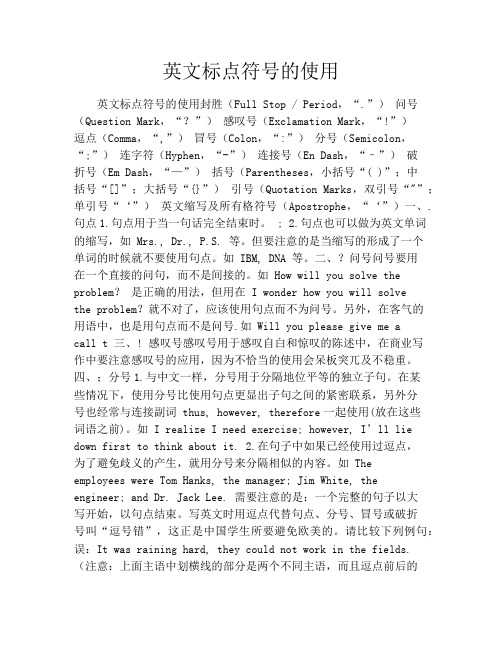
英文标点符号用法

英文标点符号使用详解A. 英语标点符号的种类1. 句点(Full Stop / Period,“.”)2. 问号(Question Mark,“?”)3. 感叹号(Exclamation Mark,“!”)4. 逗点(Comma,“,”)4. 冒号(Colon,“:”)6. 分号(Semicolon,“;”)7. 连字符(Hyphen,“-”)8. 连接号(En Dash,“–”)9. 破折号(Em Dash,“—”)10. 括号(Parentheses,小括号“( )”;中括号“[]”;大括号“{}”)11. 引号(Quotation Marks,双引号“"”;单引号“‘”)12. 缩写及所有格符号(Apostrophe,“‘”)B. 英文标点符号使用详解一、逗号英语中,逗号是最常用的标点符号,表示最短的停顿。
主要作用是:1. 用于表示并列的词语、结构或句子之间,如:He came in, took his bag, and then hurried away. 他进来,拿起他的包,然后匆匆离去了。
You, he and I should help one another. 我、你、他应该互相帮助。
2. 不属于句子组成成分的词或词组,如称呼语,插入语,well、yes、no 等,须用逗号与句子的其他成分隔开。
如:Tom, take care! 汤姆,当心!No, I don’t think so. 不,我认为不是这样。
3. 状语或状语从句置于句首时,须用逗号把它和其他成分或主句隔开。
如:On July 2, 1995, I graduated and found a teaching job in a college. 1995年7月2日,我毕业了,在一家大学找到了一份教书的工作。
If it rains tomorrow, our party will have to be put off. 如果明天下雨,我们的晚会就得推迟。
- 1、下载文档前请自行甄别文档内容的完整性,平台不提供额外的编辑、内容补充、找答案等附加服务。
- 2、"仅部分预览"的文档,不可在线预览部分如存在完整性等问题,可反馈申请退款(可完整预览的文档不适用该条件!)。
- 3、如文档侵犯您的权益,请联系客服反馈,我们会尽快为您处理(人工客服工作时间:9:00-18:30)。
Copy from: http://www.writingcentre.uottawa.ca/The CommaComma usage is in some respects a question of personal writing style: some writers use commas liberally, while others prefer to use them sparingly. Most modern North American style guides now recommend using fewer commas rather than more, so when faced with the option of using a comma or not, you may find it wise to refrain.For instance, the use of a comma before the "and" in a series is usually optional, and many writers choose to eliminate it, provided there is no danger of misreading:We bought scarves, mittens and sweaters before leaving for Iceland. (commaunnecessary before "and")We ate apples, plums, and strawberry and kiwi compote. (comma needed before"and" for clarity)Comma Usagee a comma before a co-ordinating conjunction that joins independentclauses (unless the independent clauses are very short):I wrapped the fresh fish in three layers of newspaper, but my van still smelled liketrout for the next week. (commas with two independent clauses)She invited him to her party and he accepted. (comma unnecessary withshort clauses)e a comma after an introductory adverb clause and, often, after anintroductory phrase (unless the phrase is very short):After the hospital had completed its fund-raising campaign, an anonymous donorcontributed an additional $10,000. (after introductory adverb clause)From the east wall to the west, her cottage measures twenty feet. (After introductory prepositional phrase)In the bottom drawer you will find some pink spandex tights. (no comma with short, closely related phrase)e a comma to separate items in a series:Playing in a band can be exciting, but many people do not realize the hardshipsinvolved: constant rehearsals, playing until 2 a.m., handling drunken audiencemembers, and transporting heavy equipment to and from gigs. (the commapreceding "and" is optional unless needed to prevent misreading)e commas to set off non-restrictive elements and other parenthetical elements.A non-restrictive modifier is a phrase or clause that does not restrict or limit themeaning of the word it is modifying. It is, in a sense, interrupting material that addsextra information to a sentence. Even though removing the non-restrictive elementwould result in some loss of meaning, the sentence would still make sense without it.You should usually set off non-restrictive elements with commas:The people of Haiti, who for decades have lived with grinding poverty andmind-numbing violence, are unfamiliar with the workings of a true democracy.A restrictive modifier is a phrase or clause that limits the meaning of what itmodifies and is essential to the basic idea expressed in the sentence. You should notset off restrictive elements with commas:Those residents of Ottawa who do not hold secure, well-paying jobs must resent thecommon portrayal of the city as a land of opportunity.Note that you can use two other punctuation marks to set off non-restrictiveelem ents or other parenthetical information: parentheses and dashes.Enclosing parenthetical information in parentheses reduces the importance of thatinformation:Mr. Grundy's driving record (with one small exception) was exemplary.5.Placing parenthetical information between dashes has the opposite effect: itemphasises the material:Mr. Grundy's driving record -- with one exception -- was exemplary.Nevertheless, you should usually set off parenthetical information with commas.Superfluous CommasEqually important in understanding how to use commas effectively is knowing when not to use them. While this decision is som etimes a matter of personal taste, there are certain instances when you should definitely avoid a comma.Do not use a comma to separate the subject from its predicate:[WRONG] Registering for our fitness programs before September 15, will save youthirty percent of the membership cost.[RIGHT] Registering for our fitness programs before September 15 will save youthirty percent of the membership cost.∙Do not use a comma to separate a verb from its object or its subject complement, ora preposition from its object:[WRONG] I hope to mail to you before Christmas, a current snapshot of my dog Benji.She travelled around the world with, a small backpack, a bedroll, a pup tent and acamera.[RIGHT] I hope to mail to you before Christmas a current snapshot of my dog Benji.[RIGHT] She travelled around the world with a small backpack, a bedroll, a pup tentand a camera.∙Do not misuse a comma after a co-ordinating conjunction:[WRONG] Sleet fell heavily on the tin roof but, the family was used to the noise andpaid it no attention.[RIGHT] Sleet fell heavily on the tin roof, but the family was used to the noise andpaid it no attention.∙Do not use commas to set off words and short phrases (especially introductory ones) that are not parenthetical or that are very slightly so:[WRONG] After dinner, we will play badminton.[RIGHT] After dinner we will play badminton.∙Do not use commas to set off restrictive elements:[WRONG] The fingers, on his left hand, are bigger than those on his right.[RIGHT] The fingers on his left hand are bigger than those on his right.∙Do not use a comma before the first item or after the last item of a series:[WRONG] The treasure chest contained, three wigs, some costume jewellery and fivethousand dollars in Monopoly money.[WRONG] You should practice your punches, kicks and foot sweeps, if you want toimprove in the martial arts.[RIGHT] The treasure chest contained three wigs, some costume jewellery and fivethousand dollars in Monopoly money.[RIGHT] You should practice your punches, kicks and foot sweeps if you want toimprove in the martial arts.Review: the CommaUsing a separate sheet of paper, rewrite each sentence to correct the comma usage, then compare your answer with the one provided.1.The town of Wolfville boasts spectacular tidal flats an annual apple-blossom festival,and the beautiful campus, of Acadia University.o Answer2.The university gave, the two top scholars Janet and him, gold medals and fram edcertificates of merit.o Answer3.Everyone, with tickets to the seven o'clock showing of the Rolling Stones movie,should move to the front of the line.o Answer4.Stacey who was usually quite decisive faced a true dilemma in her last year ofuniversity.o Answer5.The ring, on his finger, is solid gold.o AnswerWritten by Frances PeckThe SemicolonYou will usually use the semicolon to link independent clauses not joined by a co-ordinating conjunction. Semicolons should join only those independent clauses that are closely related in meaning.Abdominal exercises help prevent back pain; proper posture is also important.The auditors made six recommendations; however, only one has been adopted sofar.Do not use a semicolon to link a dependent clause or a phrase to an independent clause.[WRONG] Although gaining and maintaining a high level of physical fitness takes a good deal of time; the effort pays off in the long run.[RIGHT] Although gaining and maintaining a high level of physical fitness takes agood deal of time, the effort pays off in the long run.Generally, you should not place a semicolon before a co-ordinating conjunction that links two independent clauses. The only exception to this guideline is if the two independent clauses are very long and already contain a number of commas.[WRONG] The economy has been sluggish for four years now; but some signs ofimprovement are finally beginning to show.[RIGHT] The economy has been sluggish for four years now, but some signs ofimprovement are finally beginning to show.It may be useful to remember that, for the most part, you should use a semicolon only where you could also use a period.There is one exception to this guideline. When punctuating a list or series of elements in which one or more of the elements contains an internal comma, you should use semicolons instead of commas to separate the elements from one another:Henry's mother believes three things: that every situation, no matter how grim, will be happily resolved; that no one knows more about human nature than she; and that Henry, who is thirty-five years old, will never be able to do his own laundry.Written by Frances PeckThe ColonWriters often confuse the colon with the semicolon, but their uses are entirely different. When to Use a ColonThe colon focuses the reader's attention on what is to follow, and as a result, you should use it to introduce a list, a summation, or an idea that somehow completes the introductory idea. You may use the colon in this way, however, only after an independent clause:He visited three cities during his stay in the Maritimes: Halifax, Saint John andMoncton.Their lobbying efforts were ultimately useless: the bill was soundly defeated.My mother gave me one good piece of advice: to avoid wasting time and energyworrying about things I cannot change.When Not to Use a ColonYou should not place a colon between a verb and its object or subject complem ent, or between a preposition and its object:[WRONG] His neighbour lent him: a pup-tent, a wooden canoe, and a slightlybattered Coleman stove. (colon between verb and objects)[RIGHT] His neighbour lent him a pup-tent, a wooden canoe, and a slightly battered Coleman stove.[WRONG] Her three goals are: to improve her public speaking skills, to increase her self-confidence and to sharpen her sales techniques. (colon between verb andsubject complement)[RIGHT] Her three goals are to improve her public speaking skills, to increase herself-confidence and to sharpen her sales techniques.[WRONG] We travelled to: London, Wales and Scotland. (colon between preposition and objects)[RIGHT] We travelled to London, Wales and Scotland.End PunctuationThe punctuation marks that signal the end of a sentence are the period, the question mark and the exclamation mark.You use the period, by far the most common of the end punctuation marks, to terminate a sentence that makes a statement. You may also use periods with imperative sentences that have no sense of urgency or excitement attached:Without a doubt, Lady Emily was much happier after her divorce.Turn right at the stop sign.Bring me a cup of coffee and a cheese danish.When you want to express a sense of urgency or very strong emotion, you may end your imperative sentences and statements with an exclamation mark:Look out below!Leave this house at once!I hate him!Exclamation marks are, however, rare in formal writing. Use them sparingly, if at all.You should use the question mark at the end of a direct question:Who's on first?Where is my flowered cape?Be careful not to use a question mark at the end of an indirect question. Indirect questions are simply statements, and therefore end with a period:I wonder who was chosen as Harvest King in the county fair.She asked if she could play pinball.The teacher asked who was chewing gum.Quotation MarksThe exact rules for quotation marks vary greatly from language to language and even from country to country within the English-speaking world. In North American usage, you should place double quotation marks (") before and after directly quoted material and words of dialogue:One critic ended his glowing review with this superlative: "It is simply the best film ever made about potato farming."May replied, "This is the last cookie."You also use quotation marks to set off certain titles, usually those of minor or short works -- essays, short stories, short poems, songs, articles in periodicals, etc. For titles of longer works and separate publications, you should use italics (or underlined, if italics are not available). Use italics for titles of books, magazines, periodicals, newspapers, films, plays, long poems, long musical works, and television and radio programs.Once when I was sick, my father read me a story called "The Happy Flower," which was later made into a movie entitled Flower Child, starring Tiny Tim.Sometimes, you will use quotation marks to set off words specifically referred to as terms, though some publishers prefer italics:I know you like the word "unique," but do you really have to use it ten times in oneessay?"Well" is sometimes a noun, sometimes an adverb, sometimes an adjective andsom etimes a verb.Quotations Marks with Other PunctuationOne question that frequently arises with quotation marks is where to place other punctuation marks in relation to them. Again, these rules vary from region to region, but North American usage is quite simple:mas and periods always go inside the quotation marks.I know you are fond of the story "Children of the Corn," but is it an appropriatesubject for your essay?"At last," said the old woman, "I can say I am truly happy."2.Semicolons and colons always go outside the quotation marks.She never liked the poem "Dover Beach"; in fact, it was her least favourite piece of Victorian literature.He clearly states his opinion in the article "Of Human Bondage": he believes thattelevision has enslaved and diminished an entire generation.3.Question marks, exclam ation marks, and dashes go inside quotation marks whenthey are part of the quotation, and outside when they do not.Where is your copy of "The Raven"?"How cold is it outside?" my mother asked.Note that in North American usage, you should use single quotation marks (') only to set off quoted material (or a minor title) inside a quotation."I think she said `I will try,' not `I won't try,'" explained Sandy.The ApostropheYou should use an apostrophe to form the possessive case of a noun or to show that you have left out letters in a contraction. Note that you should not generally use contractions in formal, academic writing.The convertible's engine has finally died. (The noun "convertible's" is in thepossessive case)I haven't seen my roommate for two weeks. (The verb "haven't" is a contraction of"have not")To form the possessive of a plural noun ending in "s," simply place an apostrophe after the "s."He has his three sons' futures in mind.In many suburbs, the houses' designs are too much alike.Possessive pronouns -- for example, "hers," "yours," and "theirs" -- do not take apostrophes. This is the case for the possessive pronoun "its" as well: when you write "it's" with an apostrophe, you are writing a contraction for "it is."The spaceship landed hard, damaging its radar receiver. ("its" is the possessivepronoun)It's your mother on the phone. ("it's" is the contraction of "it is")The DashAs noted in the section on commas, you can use a dash at the beginning and endof parenthetical information. Usually, you will use dashes when you want to emphasise the information, but you might also use them if the parenthetical information is too long or abrupt to be set off with commas.I think you would look fine wearing either the silk blouse -- the one with the bluepattern -- or the angora sweater. (abrupt interruption)The idea of returning to the basics in the classroom -- a notion which, incidentally, has been quietly supported for years by many respected teachers -- is finally gaining som e currency with school administrators. (lengthy interruption containing internal commas)You can use a dash to conclude a list of elements, focusing them all toward one point.Chocolate, cream, honey and peanut butter -- all go into this fabulously rich dessert.Dashes also mark sharp turns in thought.We pored over exotic, mouth-watering menus from Nemo Catering, Menu du Jour, Taste Temptations, and three other reputable caterers -- and rejected them all.Review: Identifying Punctuation ErrorsIndicate whether each sentence is punctuated correctly or incorrectly.1.I wrote letters to: my aunt, the cable company, and my close friend Bernice whomoved to Boston four years ago.1.Correct2.Incorrect2."Can working with a computer really improve one's writing?" they asked.1.Correct2.Incorrect3.They read they studied and they reviewed, yet they could not define the term`onomatopoeia' on the English exam.1.Correct2.Incorrect4.Children sometimes knock at the Wilsons' door, as if taunting the couple to showthemselves, but neither the old man nor his sister ever answers.1.Correct2.Incorrect5.We cancelled our subscription to the magazine after it ran a homophobic article;likewise, a number of our friends boycotted the publication.1.Correct2.Incorrect6.My sister's skin used to be as smooth as a childs.1.Correct2.Incorrect7.Aaron asked the counsellor if there were many job opportunities for music teachersand if he would have to leave the province to get a good position?1.Correct2.Incorrect8.They wanted very badly to see Peter Weirs new film, but fate in the form of the year'sworst snowstorm intruded.1.Correct2.Incorrect9.How could the rent review administrators have made such a decision, and how willyour landlord live with himself?1.Correct2.Incorrect10."Take me with you," she said. "This little town and it's little people are more than Ican bear, but I know everything will be different in New York".1.Correct2.IncorrectReview: Adding PunctuationUsing a separate sheet of paper, punctuate each sentence, then compare your answer to the one provided.st Tuesday the committee agreed on its guest speakers for the coming year.o Answer2.I really enjoyed Lost Ground the new short story by William Trevor said Samuel.o Answer3.Guido who is my fathers cousin was born in Naples.o Answer4.His form was excellent his dive was superior to his other competitors attempts.o Answer5.My sisters favourite foods are as follows pepperoni pizza applesauce andstrawberries.o AnswerWritten by Frances Peck。
